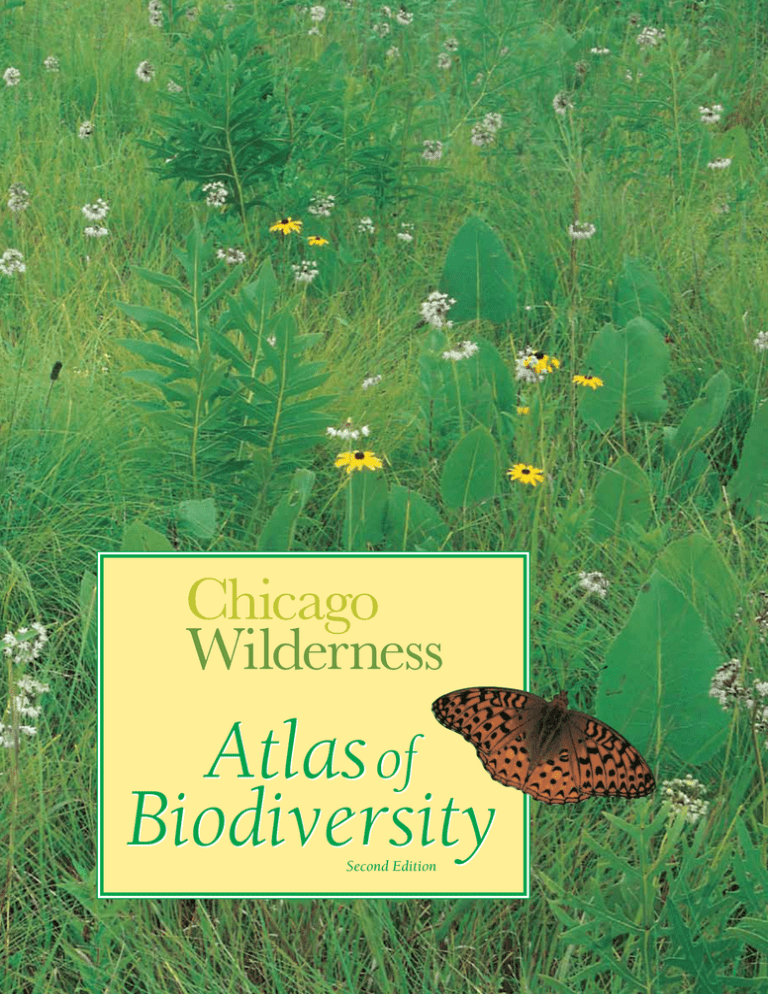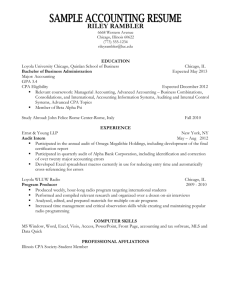Atlas Biodiversity of
advertisement

Atlas of Biodiversity Second Edition Atlas of Biodiversity Second Edition First published in 1997, the Chicago Wilderness Atlas of Biodiversity provides an introduction to our region’s natural treasures. With more than 60,000 copies in circulation, it celebrates our globally significant prairies, woodlands, wetlands, lakes and streams, as well as the many animal species that depend upon them for survival. The nationally-recognized Atlas also chronicles the roles that development and urbanization have played in altering our native landscape, along with the restoration efforts of an expanding alliance of local, state and federal agencies, nonprofit organizations, educational institutions, municipalities, corporate partners and individual volunteers. This updated version of the Atlas retains the substance of the first, but has been updated to reflect the many changes over the past several years. New sections include those on climate change and water resources, both of which are growing concerns globally as well as locally. Another new section is the Green Infrastructure Vision, which outlines a strategy to greatly expand the number of acres preserved as natural areas. The Atlas is a vital resource for students, educators and the general public. However, for those who wish to learn more, the Chicago Wilderness Biodiversity Recovery Plan provides an outline for recovering the health of the native habitats and animals celebrated in the Atlas. To measure progress toward these recovery goals, in 2006 Chicago Wilderness published The State of Our Chicago Wilderness, A Report Card on the Health of the Region’s Ecosystems. The Atlas of Biodiversity is a publication of the Chicago Wilderness alliance. Copyright 2011. Funds for this publication were provided by the USDA Forest Service, the US Fish & Wildlife Service, and the Chicago Wilderness Corporate Council. Contents INTRODUCTION 3 GEOLOGY OF THE CHICAGO WILDERNESS REGION 4 LIVING COMMUNITIES 11 PRAIRIES 12 Animals 18 WOODED COMMUNITIES Introduction 22 Savannas 24 Open Woodlands 25 Flatwoods 26 Forests 27 Animals 28 WETLANDS Introduction 32 Marshes and Shrub Swamps 34 Sedge Meadows 35 Fens 36 Bogs 37 Animals 38 STILL WATERS Lakes and Ponds 42 MOVING WATERS Streams and Rivers 44 THE DUNES 46 LAKE MICHIGAN 47 the water cycle 48 climate change 49 people on the land Native Americans 50 Settlement 51 The Creation of the Forest Preserves 54 Restoration and Management 56 How We're Doing 60 green infrastructure vision 62 leave no child inside 64 conclusion 65 APPENDICES AND INDEX 66 Endangered and Threatened Species in Illinois Rare and Endangered Natural Communities in the Chicago Wilderness region Kishwaukee Kishwaukee Kishwaukee Kishwaukee Kishwaukee Kishwaukee Kishwaukee Kishwaukee er er er iv iver iv RRRiv oR ic icaaaaggggooo ic hhhic CCCCh ine ine Pla Pla Plaine inesssss ine Pla Des Des DesPla Pla Des Des Des ooottttt RRRRRooooooo Galien Galien Galien Galien Galien Galien Galien Galien Fox Fox Fox Fox Fox Fox Fox Fox 0 Iroquois Iroquois Iroquois Iroquois Iroquois Iroquois Calumet Little Calumet Little Calumet Little Calumet Little Calumet Little Little Calumet Little Calumet Little Calumet Kankakee Kankakee Kankakee Kankakee Kankakee Kankakee Kankakee Kankakee Illinois Illinois Illinois Illinois Illinois Illinois Illinois Illinois Critically imperiled 10 20 miles Globally imperiled Globally Nature in the Metropolis People and Nature in the Chicago Wilderness Region E mbedded in one of North America’s largest metropolitan regions and stretching along Lake Michigan from southeastern Wisconsin, through northeastern Illinois, into northwestern Indiana and southwestern Michigan is a mosaic of natural areas that includes nearly 370,000 acres of protected lands and waters. The natural areas of Chicago’s wilderness are home to a wide diversity of life and globally rare habitats— prairie, pannes, coastal wetlands, oak savanna, fens, sedge meadows, flatwoods, and more. Thousands of native plant and animal species live here among the more than nine million people who also call the region home. Nature offers us many benefits: wondrous places for play, recreation, and exploration, as well as opportunities for learning, discovery and spiritual renewal. Healthy ecosystems also provide us essential services, including fresh air, clean water, healthy soil, flood protection, pollution filtering, and habitat for plants and wildlife. As residents of the Chicago Wilderness region, we are fortunate to have access to a relatively large amount of open space and natural areas. But, over the past two centuries, Chicago’s wilderness has been greatly impacted by farming, industry, and development. Local nature now faces serious threats, including fragmentation of green open spaces; invasive plant and animal species like buckthorn, garlic mustard, and zebra mussels; pollution; and the impacts of global climate change. Founded in 1996 with the mission of preserving and restoring the biodiversity of the region and collectively addressing these threats, the Chicago Wilderness alliance is made up of local, state and federal agencies, large conservation groups, education institutions, grassroots volunteer groups, municipalities, faith-based groups, and corporate partners. Alliance members work together to restore local nature and improve the quality of life for all living things by protecting the lands and waters on which we all depend. An energized network of volunteers, stewards, citizen scientists, and monitors also works tirelessly throughout the region in collaboration with land management agencies to protect and restore nature for their families and future generations. Please join us in celebrating our treasured communities of plants and animals. Learn more about them in the Atlas, and then go exploring for yourself—there is a lot of nature to see in our metropolis’ many parks and preserves.



